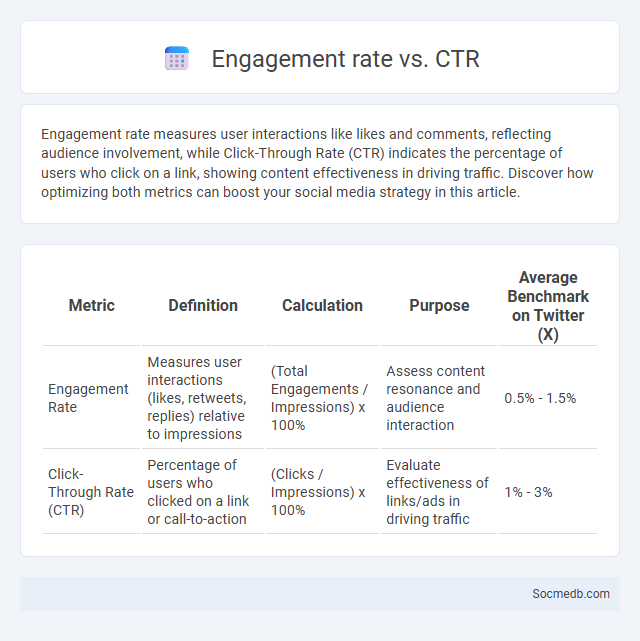
Photo illustration: Engagement rate vs CTR
Engagement rate measures user interactions like likes and comments, reflecting audience involvement, while Click-Through Rate (CTR) indicates the percentage of users who click on a link, showing content effectiveness in driving traffic. Discover how optimizing both metrics can boost your social media strategy in this article.
Table of Comparison
| Metric | Definition | Calculation | Purpose | Average Benchmark on Twitter (X) |
|---|---|---|---|---|
| Engagement Rate | Measures user interactions (likes, retweets, replies) relative to impressions | (Total Engagements / Impressions) x 100% | Assess content resonance and audience interaction | 0.5% - 1.5% |
| Click-Through Rate (CTR) | Percentage of users who clicked on a link or call-to-action | (Clicks / Impressions) x 100% | Evaluate effectiveness of links/ads in driving traffic | 1% - 3% |
Understanding Engagement Rate: Definition and Metrics
Engagement rate measures the level of interaction a social media post receives relative to the total audience, commonly calculated by dividing total engagements (likes, comments, shares) by the number of followers or impressions. Key metrics include likes, comments, shares, clicks, and saves, which collectively indicate content relevance and audience interest. Optimizing engagement rate helps brands refine content strategies, improve reach, and boost overall social media performance.
What is Click-Through Rate (CTR)? Key Insights
Click-Through Rate (CTR) measures the percentage of users who click on a specific link or ad out of the total viewers, serving as a crucial metric in social media marketing. A higher CTR indicates strong engagement and the effectiveness of your content in driving traffic to desired destinations such as websites or landing pages. Understanding CTR helps optimize campaigns by identifying which posts resonate with your audience and improve overall digital advertising performance.
Exploring Social Media Reports: Overview and Importance
Social media reports provide detailed analytics on user engagement, content performance, and audience demographics, which are crucial for refining marketing strategies. These reports harness data from platforms like Facebook, Instagram, and Twitter to track metrics such as reach, impressions, and click-through rates, enabling businesses to measure campaign effectiveness. Understanding trends and sentiment analysis in social media reports helps companies optimize content, improve customer interaction, and increase brand visibility.
Engagement Rate vs CTR: Main Differences
Engagement rate measures the total interactions such as likes, comments, and shares relative to followers, reflecting audience involvement and content resonance on social media platforms. Click-Through Rate (CTR) calculates the percentage of users who click on a specific link or call-to-action within a post, indicating the effectiveness of driving traffic to external websites or landing pages. Understanding the distinction helps marketers optimize content strategies by balancing brand awareness through engagement and conversion-focused actions via CTR.
How Reports Integrate Engagement and CTR Data
Reports integrate engagement and click-through rate (CTR) data by aggregating user interactions such as likes, shares, comments, and link clicks to provide a comprehensive view of content performance. This integration enables you to analyze how engaging your social media posts are while simultaneously measuring the effectiveness of your call-to-action links. By combining these metrics, businesses can optimize their content strategy and improve overall audience response.
Measuring Success: When to Use Engagement Rate
Engagement rate is a critical metric to measure the effectiveness of your social media campaigns by quantifying interactions such as likes, comments, shares, and clicks relative to your follower count or impressions. You should use engagement rate to assess content resonance, identify audience preferences, and optimize posting strategies for increased visibility and follower growth. Tracking this metric consistently helps you determine whether your social media efforts are building meaningful relationships and driving interaction with your brand.
CTR Analysis: Best Use Cases
CTR analysis in social media campaigns reveals how effectively your content drives user engagement by measuring click-through rates on ads and posts. Best use cases include optimizing ad creatives for higher conversion, tailoring audience targeting based on click patterns, and improving landing page relevance to boost overall ROI. Leveraging detailed CTR data allows you to refine strategies, maximize ad spend, and increase conversion rates substantially.
Interpreting Reports for Improved Marketing Strategies
Analyzing social media reports provides critical insights into user engagement metrics, audience demographics, and content performance, enabling marketers to tailor campaigns effectively. Interpretation of data such as click-through rates, conversion rates, and sentiment analysis helps identify trends and optimize targeting strategies. Leveraging these insights enhances ROI by refining messaging, selecting optimal posting times, and focusing on high-impact channels.
Common Mistakes Comparing Engagement and CTR
Comparing social media engagement and click-through rate (CTR) often leads to misunderstandings because they measure different types of user interactions: engagement tracks likes, comments, and shares, while CTR focuses on the percentage of users who click on a link. Your marketing strategy may suffer if you treat engagement as a direct indicator of CTR, as high engagement does not necessarily translate to more clicks or conversions. Focusing on the right metric according to your campaign goals ensures more accurate performance analysis and better optimization.
Choosing the Right Metric for Your Campaign Goals
Selecting the right metric for your social media campaign depends on clearly defined goals such as brand awareness, engagement, or conversions. Metrics like impressions and reach are ideal for measuring awareness, while likes, comments, and shares effectively track engagement. Conversion rates, click-through rates (CTR), and return on ad spend (ROAS) provide critical insights when the goal is to drive sales or leads.
 socmedb.com
socmedb.com